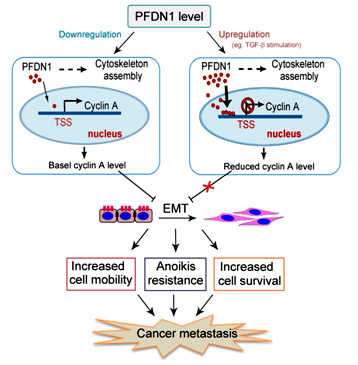Researchers in the Institute of Biochemistry and Cell Biology of SIBS identified a new function of prefoldin 1 (PFDN1). PFDN1 suppresses the expression of cyclin A, induces EMT (epithelial-mesenchymal transition), and the EMT-associated changes of cells behaviors, leading to the promotion of lung cancer progression.
As a co-chaperone protein molecule, PFDN1 is primarily known for its cytoplasmic function in the folding of actin and tubulin monomers, which is important for cytoskeletal assembly and rearrangement. Cytoskeleton rearrangement is an important link of EMT processes, while TGF-b is one of the most potent inducer of EMT. Increasing evidence demonstrated that both TGF-β and EMT are closely implicated in the embryonic development, tissue repair, and cancer invasion and metastasis. However, very little is known about the role of PFDN1 in EMT and relevant biological events. Jianguo Song and Dongmei Wang et al, observed that the PFDN1 expression can be upregulated by TGF-b1 and its level is markedly increased during TGF-b1-induced EMT. The nuclear location of PFDN1 was also observed. Besides, PFDN1 was found to be significantly increased in some cancer tissues. PFDN1 overexpression can induces the EMT and EMT-related cell changes, promoting the xenograft growth and the distal metastasis of lung cancer cells. Their follow-up investigation also revealed that the novel function of PFDN1 is linked with its transcriptional inhibition of cyclin A expression. This study uncovered that TGF-b1/PFDN1/cyclin A axis plays an important role in EMT and metastatic capacity of lung cancer cells (as illustrated below), which could be helpful in the relevant pharmaceutical and clinic considerations for lung cancer treatment.

Illustration: PFDN1 functions through cyclin A-controlled EMT in lung cancer progression
Reference
DM Wang, WW Shi, YN Tang, Y Liu, K He, Y Hu, JS Li, YX Yang, and JG Song. Oncogene advance online publication, 3 October 2016; doi:10.1038/onc.2016.257.
Author affiliation
State Key Laboratory of Cell Biology, Innovation Center for Cell Signalling Network, Institute of Biochemistry and Cell Biology, Shanghai Institutes for Biological Sciences, Chinese Academy of Sciences, Shanghai 200031, China
 Appendix:
Appendix: